JHVEPhoto
As I mentioned in my initial article on Novo Nordisk (NVO), this is the sort of company that you really want to own, though at the right price. This is a dominant player in top international fields of medicine. The company is the largest player in Diabetes medicine/treatment and controls over 30% of the global market, including a massive 44% of the global insulin market.
With such numbers, it’s no wonder that Novo Nordisk carries a significant premium based simply on what it is and what it offers.
That’s even before going into superb historical RoR results, some excellent margins, and some great asset rotation strategy that has proven to be very profitable, overall.
This company has absolutely superb return metrics, sector-leading margins, and a very efficient asset strategy that’s allowed for some superb returns throughout the past few years.
Updating on Novo Nordisk
Novo Nordisk has, as I mentioned, some absolutely stellar fundamentals. This is the first reason why you’d want to invest in a company like this. Novo Nordisk leads diabetes, and diabetes leads sales with 80% of total sales. Other areas that the company focuses on are growth disorders, obesity, and other adjacent treatment areas to diabetes, but none of these make up more than 4-8% of the overall company annual sales.
With 30% of the global market under a growing disease/condition under its control, Novo Nordisk has been a superb accumulator of value and earnings, with significant sales growth year-over-year for over 10 years.
Earnings have, in fact, accelerated even more, not less during the past year. The company continues to focus on its main line – diabetes. With over 537M people with the disease, this is a no-brainer, though the company’s other treatment areas may actually end up outpacing these – especially obesity.
Novo Nordisk Portfolio (NVO IR)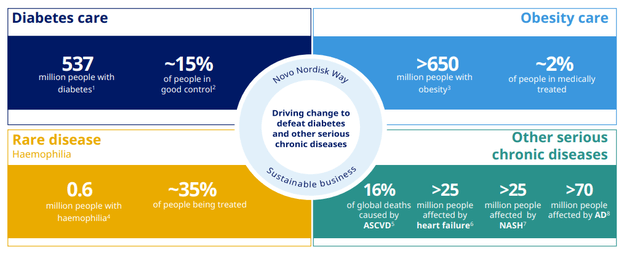
Now, healthcare usually doesn’t treat obesity like something such as diabetes – but it’s still a very interesting field the company is going into here. Aside from Obesity, you can see that the company is also moving into other rare diseases which don’t exactly have the same sort of case numbers, but are still important because most of the people afflicted are being actively treated.
Novo Nordisk has stellar credit and is rated AA- by S&P Global with similar ratings across the board. The company is not a high sort of dividend payor, coming in at a historical 1-2% – not exactly something to take to the bank that often.
But dividends are not why you buy Novo Nordisk – safety, growth, and exposure to appealing markets are your target when you start investing here.
Novo Nordisk is owned 28.1% by the Novo Nordisk Foundation, which owns voting-class strong sharers that amount to 76.7% of the voting rights, meaning a majority decision-making power in the company. Other strong shareholders are BlackRock (BLK), Vanguard, and the Norwegian State. No matter which way you lean here, this company has committed, long-term owners, and you will not be part of the decision-making – neither will anyone else.
Going forward, the company will focus on a number of things. Expectations are for the diabetes market to essentially normalize more, and dial down growth to around 1-2%. The expectation is also for the demand for Insulin to flatten/drop somewhat, while oral diabetes drugs are set to grow perhaps somewhat more. Diabetes prevalence is only increasing, yet only 50% of current people are ever diagnosed, and many adults go undiagnosed.
It’s important not to understate the potential of the company’s core treatment areas – which are significant. The company has a full-range portfolio of every solution necessary on the market.
Novo Nordisk Insulin Portfolio (NVO IR)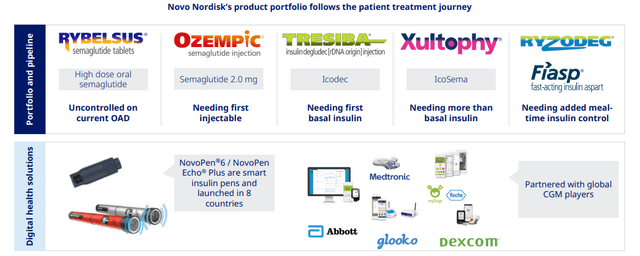
The use of GLP-1 treatments is already increasing on a global level, yet only 6 million are, as of yet, being treated, meaning only 3% of all diabetes scrips use the technology, leaving a huge potential market to address. China also remains a massive opportunity for the company, with over 140 million people living with diabetes, which is actually 22-23% of the total patients worldwide – this also lines up well with the company’s sales numbers, where China makes up around 22%. Still, as of yet, GLP-1 technology treatments are very few compared to the larger market, especially when looking at the global market.
The picture that the company wants to give us is that Novo Nordisk is only in the beginning of increasing its sales, thanks to its portfolio of excellent products. There is a lot of truth in this, but also a lot of truth in the fact that competition is increasing.
The pricing for Insulin is under massive, global pressure and this is likely to continue. The USA is a huge market for Novo, with over 45% of sales. Recent presidential cycles in 2020-2022 have focused on starting to pressure the prices on some of these medications. Despite the companies already offering discounted refills, the pressures in this segment are definitely here to stay. Besides pricing, competition has intensified via Eli Lilly’s competition through its GLP-1 candidate Trulicity, which has been in the market since 2014 and is taking market share (primarily new patients) from Novo’s Victoza (2010 US approval).
These pricing/competitive concerns are also what forced, as mentioned Sanofi (SNY) to suspend its R&D completely in the diabetes space. So, Sanofi is completely out of the space here, leaving NVO and other companies uncontested.
However, potential competition aside, NVO has always been about the successful managing of life cycles. The company has a slew of legacy insulin products that have faced headwinds during recent years, resulting in the top positions being passed to even more modern and innovative products which have been able to make up for the price erosion of legacy insulin. So, NVO has been keeping pace.
Investing in NVO is a bet on the assumption, a bullish one, that they can continue to do just that – while at the same time moving into new treatment areas.
Saxenda, its obesity medication, controls a staggering 65% of the global market for Obesity, a market with a TAM of $1.5B of 650M people. Only 15M of them is being treated, meaning this is a massive opportunity, and the company expects the number of patients to increase by 10M by 2025.
So – the upside does exist, and we need to watch it.
The company is also pushing into entirely new treatment areas such as cardiovascular, non-alcoholic steatohepatitis, chronic kidney, and Alzheimer’s.
So, Novo Nordisk is not just a bet on the successful management of insulin and obesity meds, but also the potential of a class-leading pharma company finding yet another blockbuster in a relevant treatment area.
These pushes are clear signs that management is acknowledging that being the market-dominating force for Diabetes may no longer be enough for the growth that investors have come to associate with long-term investing in Novo Nordisk.
So, the company is pushing beyond this. Over time, the company has proven beyond doubts that it can deliver returns. Let’s see what the future looks like, now that we’re 5% below the previous level.
Novo Nordisk Valuation
As I mentioned, in my initial article, I use three distinct methods to value NVO – or really most companies. DCF, forecasts, and peers (and sometimes NAV).
When it comes to DCF, I still assume a 4-6% EBITDA growth rate due to increased penetration of GLP-1 products. I see, at this point, no reason to change this assumption. A 4-6% growth rate in EBITDA is actually below the historical norm, but I believe this more accurately reflects the company’s current position and forecasts, as legacy insulin products are set to continue their decline.
The resulting DCF on a WACC of 6.84% with a cost of debt, up to 4% (assumed) is a range between 670-720 DKK/share. This is, quite obviously, well below the current share price.
The simple fact remains that every indication is that this company continues to trade at that chronic premium valuation I noted during the past piece. Despite what can only be characterized as “superb” growth rates, this pharma company with its close to 1% yield, still trades at a premium of nearly 34X P/E.
NVO Valuation (F.A.S.T graphs)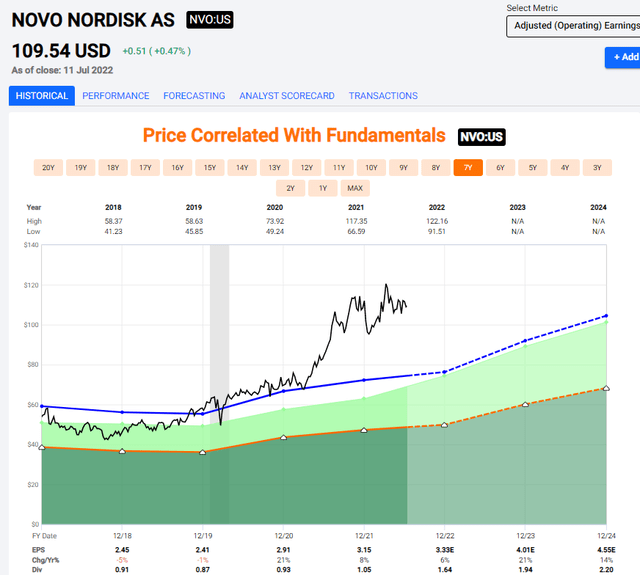
Let me put this in very simple terms. Even if this company’s average 12-13% currently assumed growth rates do materialize (and I believe closer to 4-7%), there’s no way I’m paying a 34X P/E premium for a company like this. Not even one that’s AA- rated. Not even one that has this sort of history. I forecast NVO at closer to 5-year averages, which come to around 22X P/E. Based on a 22X P/E forward valuation, the company’s potential RoR is actually negative there.
There is simply not enough – or any – upside even in a premium assumption for me to become interested in investing here. Even if we go to 26-28X, that RoR underperforms inflation at below 6-7%.
Technically, S&P Global analysts believe NVO to be undervalued here. Taking the native share price of currently 810 DKK per share, this comes to around a 10% undervaluation to the overall analyst target of 881 DKK per share by analysts. However, that 10-12% premium is something these analysts have held for a couple of years at least.
Any target above a 720 DKK multiple assumes a premium for the company that I’m very uncomfortable with – and would not invest in. That’s why I myself sold the company after waiting around for a long time, at close to 800 DKK some time ago.
The picture I want to deliver to you is very clear.
Novo Nordisk Is overvalued here – at least 10%.That’s the very least we could consider the overvaluation at over 800 DKK per share.
Therefore, my answer to you is still “HOLD” here.
Thesis
My thesis for Novo Nordisk is as follows:
- Novo Nordisk is a great business that can really be bought into virtually any long-term investor’s portfolio.
- However, the company’s specifics dictate that you should be careful about NVO and when to buy it.
- I believe Novo Nordisk will come down from its lofty heights, and normalize closer to 20-25x P/E, at which point savvy valuation investors, such as myself and yourself, potentially can pick it up if our portfolio allows for it.
- My target for the company is no more than 720 DKK here – so still an overvaluation in the double digits.
Remember, I’m all about:
-
Buying undervalued – even if that undervaluation is slight, and not mind-numbingly massive – companies at a discount, allowing them to normalize over time and harvesting capital gains and dividends in the meantime.
-
If the company goes well beyond normalization and goes into overvaluation, I harvest gains and rotate my position into other undervalued stocks, repeating #1.
-
If the company doesn’t go into overvaluation, but hovers within a fair value, or goes back down to undervaluation, I buy more as time allows.
-
I reinvest proceeds from dividends, savings from work, or other cash inflows as specified in #1.
Here are my criteria and how the company fulfills them.
- This company is overall qualitative.
- This company is fundamentally safe/conservative & well-run.
- This company pays a well-covered dividend.
- This company is currently cheap.
- This company has realistic upside based on earnings growth or multiple expansion/reversion.


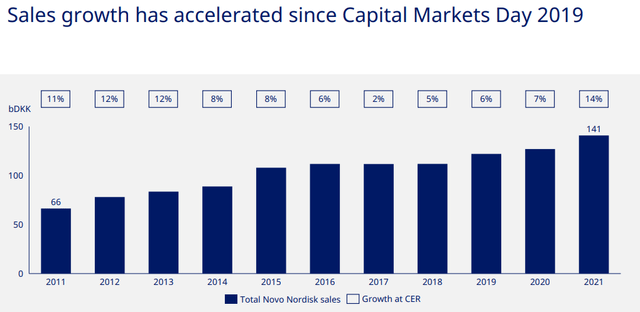
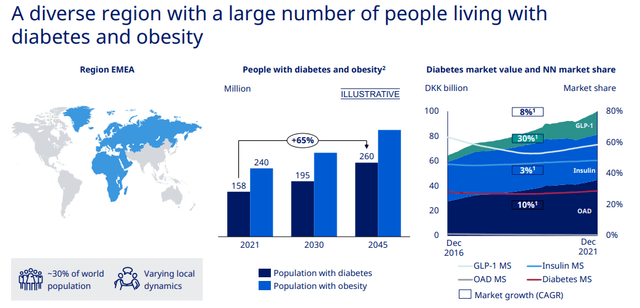
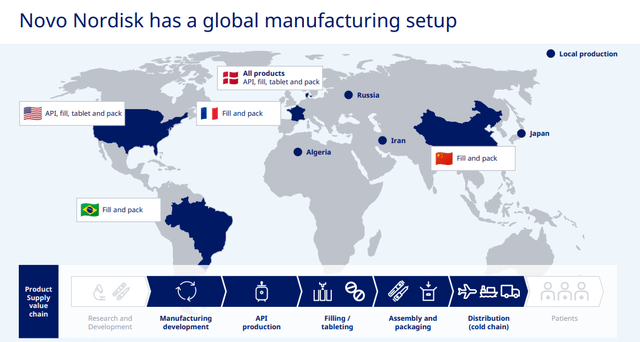
Be the first to comment